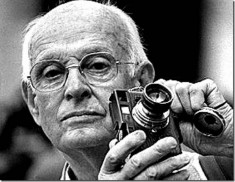| Henri Cartier-Bresson | |
|---|---|
 |
|
| Photographer | |
| Born | Aug 22, 1908 Chanteloup-en-Brie, France |
| Died | Aug 3, 2004 (at age 95) Montjustin, France |
| Nationality | French |
Henri Cartier-Bresson is considered to be a founding father of modern photojournalism. His passion and work took him to different parts of the world and he photographed several major international events in his time, such as the Spanish Civil War and the 1968 French uprisings.
Early Life
Henri Cartier-Bresson was born in Chanteloup, France, on August 22, 1908. He grew up in a family with four younger siblings. His father earned a high income as a textile manufacturer, but his parents raised the children up in a frugal lifestyle.
Schooling Years
Cartier-Bresson received his education in Paris. He showed an inclination for literature and arts from an early age, reflecting his artistic family background with an artist for a great-grandfather, a printer for an uncle, and a father who was into drawing.
He was rebellious toward his parents during his teenage years and on becoming an adult, he took an interest in communism. Nonetheless, art continued to be the focus of his life, and in 1927 he studied painting for two years under André Lhote, a famous early Cubist. Afterwards, he attended Cambridge University where he undertook more courses in art and literature.
Photography Inspiration
After getting inspired by the Parisian avant-garde scene while serving in the army, Cartier-Bresson went hunting in Africa in 1931 where he developed an interest in photography. He took his first photos with a basic Brownie that had been given to him as a gift.
He then bought a 35mm Leica camera when he returned to France. Cartier-Bresson’s preference was for a simple photography style without any augmented or artificial effects, a naturalist approach that he employed throughout his career. Part of this involved doing editing during the process of making the image.
Career and Major Achievements
 He gained early success in his photography career with his work being displayed at major exhibitions across the world during the mid 1930s, including New York, Mexico, and Madrid. But in 1935, Carter-Bresson left photography for three years to serve as a film assistant under Jean Renoir, a French filmmaker.
He gained early success in his photography career with his work being displayed at major exhibitions across the world during the mid 1930s, including New York, Mexico, and Madrid. But in 1935, Carter-Bresson left photography for three years to serve as a film assistant under Jean Renoir, a French filmmaker.
In 1940, Cartier-Bresson joined the army during WWII, but after the Germans invaded France, he was held as a prisoner of war for three years. He escaped in 1943 and soon after, he formed a photography department for the resistance. After the war, he directed a U.S.-commissioned documentary on the return of French prisoners.
Not long after that, he journeyed to the east and during his travels in India, he photographed Mahatma Gandhi just before he was assassinated in 1948. His documentation on Gandhi’s death earned the status of being a prized photo essay by Life magazine.
More Extensive Work
Cartier-Bresson was one of the founders of the international premier photo agency Magnum Photos, established in 1947. In 1952, he published The Decisive Moment, his first book which documented his work over two decades. He also traveled extensively and documented several key international events with his Leica during his career, including the Spanish Civil War, the Chinese revolution, George VI’s coronation, and communist Russia under Khruschev.
He photographed many notable figures as his subjects, such as Che Guevara and Marilyn Monroe, and had several top magazine clients, like Life magazine, Harper’s Bazaar, and Vogue.
Later Life and Death
Cartier-Bresson quit Magnum Photos in 1966 and he went back to drawing and painting. With the help of his wife and daughter, he created the Henri Cartier-Bresson Foundation in Paris in 2003 to preserve his life’s work. Thereafter Cartier-Bresson was awarded many awards and honorary doctorates for his achievements. He died at his Provence home on August 3, 2004, at the age of 95.